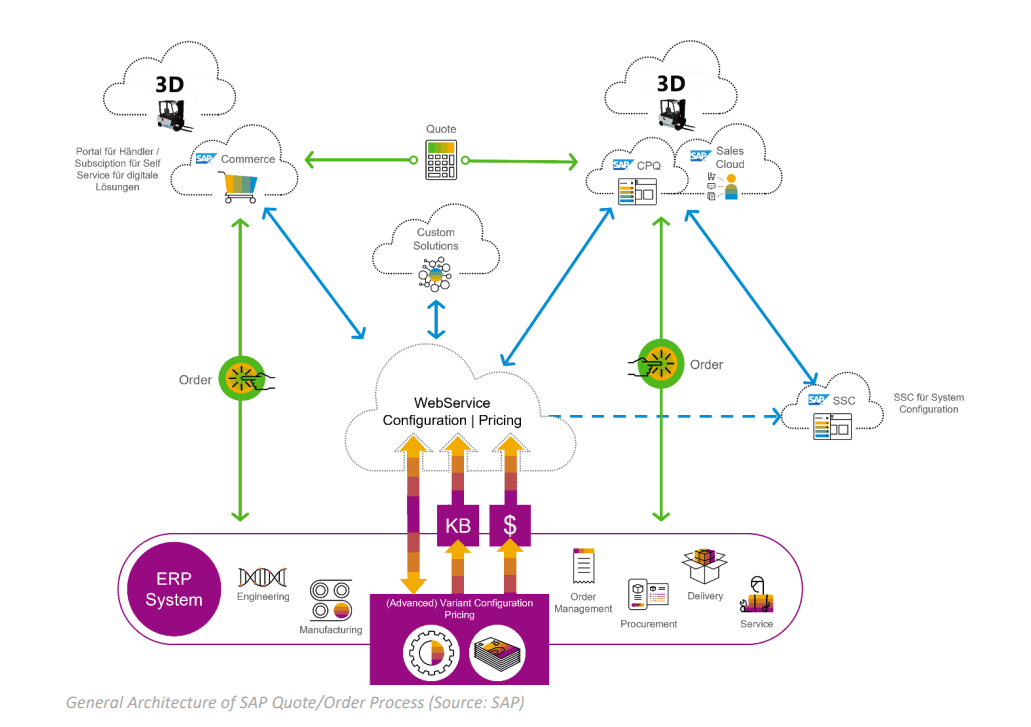Organization optimization processes are endless as there is no limit when it comes to maximizing business capabilities. Various processes associated with customer inquiries, order entry, and sales cycle management are seeking to be automated by companies of all sizes.
Configure, Price, Quote, and Variant Configurator integration offer a range of benefits for organizations. By combining these two technologies, organizations can create a seamless and intuitive process for configuring and quoting products and services, improve customer satisfaction, reduce costs, and increase sales.
Keep reading to learn about SAP CPQ and SAP LO-VC solutions, their benefits, and how to leverage your investment in SAP Variant Configurator configuration and pricing rules.
Content
What are SAP CPQ and SAP LO-VC?
SAP CPQ (Configure, Price, Quote) is a tool used by manufacturers to generate accurate and detailed quotations and customize product configurations. A clear understanding of the costs associated with a product can facilitate the sale process and make an informed purchasing decision easier for customers.
SAP LO-VC (Logistics Variant Configuration), on the other hand, enables manufacturers to create complex product configurations that take a variety of factors into accounts, such as product options, materials, and pricing rules. This way, custom product configurations to satisfy the unique needs of their customers are developed.
When SAP CPQ and SAP LO-VC are combined, they can assist manufacturers in streamlining their product configuration process, providing their customers with exactly what they require, and creating accurate and detailed quotes. This can help to increase efficiency, reduce the risk of errors and misunderstandings, and ultimately drive more sales.
If you have SAP ERP or SAP S/4HANA and use a variant configurator to manage configuration and pricing rules and want to purchase a CPQ solution, the following are the points to consider.
What are the integration differences between SAP LO-VC and SAP AVC?
- Anything written with ABAP (pricing user exits, pricing Badi, price condition/access table user exits, variant functions, etc) is automatically exposed with AVC, but for LO-VC, the pricing and customizing configurations/implementations should be exposed to the cloud either via an ABAP based environment or the SAP CAP Backend on the BTP side. Alternatively, ABAP on SAP BTP includes the development of restful APIs for both pricing and configuration aspects under the SAP RAP Framework. If exposure on the SAP CAP backend (CAP Framework) is considered, for the APIs creation, the ABAP codes would have to be converted to JS codes. These APIs should then be externally exposed via SAP APIM (API Management) and called in the CPS admin UI.
- Latency with LO-VC will be higher than with AVC due to the difference in CPS integration and performance optimization of AVC as the engine. In the case of SAP AVC, SAP CPS directly accesses KMATs in the backend SAP S/4, while with SAP LO-VC, SAP CPS stores an instance of the KMAT with pricing and configuration rules.
- The S/4HANA 2022 release on AVC includes numerous new features and performance improvements.

What factors to consider when choosing the right CPQ solution?
SAP CPQ is the best option to consider if you have made an investment in a back-end variant configurator that you want to use with your CPQ solution.
- Integration of an external front-end application, such as CPQ or a customer portal, on top of Variant Configurator is a costly exercise that cannot be completed on the project. The complexity lies in consuming configuration API and developing mapping logic that will display the product in an external application with a predefined layout and allow configuration rules to be executed in the same order as on the backend. The pricing service must go through the same mapping process. Even though VC can be exposed via SAP CPS and customers with S/4HANA licenses already have SAP CPS, our experience shows that the investment in integrating CPS with your external front-end application will be around 3000-4000 MDs.
- Instead of building integration, use SAP CPQ and concentrate on building the customer requirements into the system.
- SAP CPQ integrates natively with Variant Configurator via SAP CPS. This means that the mapping/consumption logic for SAP CPS pricing and configuration services, which then consume AVC/LO-VC pricing and configuration rules, is already pre-built. So, all that remains for the customer to do is activate the integration, which is typically handled by the project’s technical/basis team.
- SAP CPQ supports a hybrid integration scenario with VC, allowing you to consume what has been built on the pricing/configuration side of VC while also redefining some of the price conditions and changing the layout on the SAP CPQ side. As you can imagine, building integration with VC and then supporting this hybrid integration setup with project-built integration will be quite complex.
- If you have an external ERP system and S/4HANA/SAP ERP VC is only used for a portion of your business, SAP CPQ can provide a smooth migration path. You can achieve a quick go-live by enabling Variant Configurator standard integration with SAP CPQ for your S/4HANA/SAP ERP and then introducing offers on SAP CPQ that do not rely on Variant Configurator on the backend for your external ERP. We have customers who want to migrate from multiple external ERPs to S/4HANA. However, due to long implementation timelines and urgent business needs, it is necessary to move external ERP pricing and configuration logic into SAP CPQ in order to later activate VC on S/4HANA and switch over the quotation process to new VC-based offers (all this can be done without any migration).
- If the customer decides to migrate from LO-VC to AVC using standard S4/HANA transformation tools, SAP CPQ will be able to receive these newly migrated materials via an already configured SAP CPS.
Where to store pricing and configuration rules?
Customers may find it difficult to determine where pricing and configuration rules for all lines of business/company codes will be stored. SAP CPQ can give the customer freedom and not force them to decide before the CPQ journey begins. Customers who choose SAP CPQ can select one of the following options at any time during their CPQ journey.
All the following options are available within a single SAP CPQ tenant:
- have pricing and configuration rules on SAP CPQ – for the entire company or for a subset (specific CoCo, Plant, line of business).
- have pricing and configuration on SAP AVC – for the entire company or for a subset (specific CoCo, Plant, line of business).
- have pricing and configuration on SAP LO-VC – for the entire company or for a subset (specific CoCo, Plant, line of business).
- have hybrid pricing and configuration on SAP CPQ and leverage SAP AVC/LO-VC – for the entire company or for a subset (specific CoCo, Plant, line of business).
What are the benefits of moving to SAP CPQ?
- SAP VC investment leverage.
- Optimization of project timelines by at least 12 months.
- Significant optimization of project costs.
- Optimization of business users’ time for project implementation and operations by focusing on meeting business requirements.
- Keeping all options open for the entire CPQ journey – pricing on CPQ, pricing on VC, hybrid pricing approach, exposing pricing from CPQ or from CPS.
The Bottom Line
The combination of SAP CPQ and SAP Variant Configurator provides businesses with an efficient tool for managing sales processes, optimizing project timelines, and maximizing investment. With the integration of these two solutions, businesses can leverage the powerful capabilities that each offers to get a comprehensive way to manage the entire product configurator process and provide a superior customer experience.
